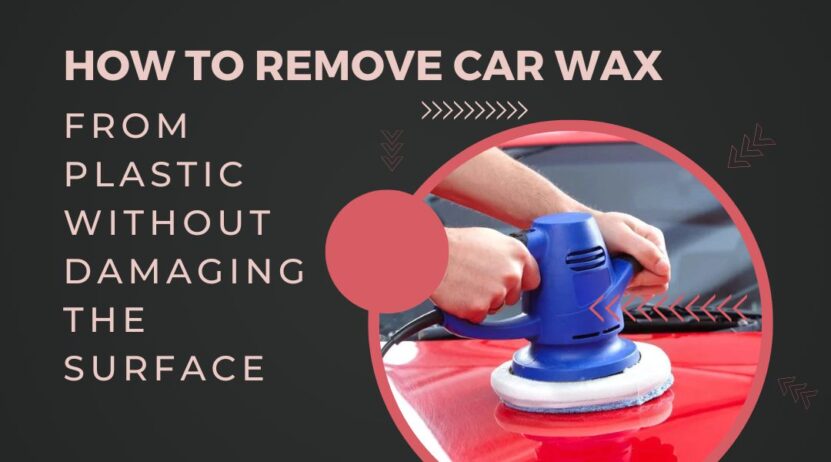Car wax is a popular way to protect and enhance the appearance of a car’s exterior. However, sometimes wax can accidentally get onto plastic parts of the car, such as the trim or bumper, and create an unsightly residue. Removing car wax from the plastic can seem like a daunting task, but with the right tools and techniques, it can be done easily and effectively.
In this guide, we will explore the best methods for removing car wax from plastic, including using household items and specialized cleaning products. Whether you are a car enthusiast looking to maintain the pristine appearance of your vehicle or simply trying to clean up a wax spill, this guide will provide you with the steps and tips you need to get the job done right.
Pre-Cleaning

Before you start to remove car wax from plastic, it is important that you do a pre-cleaning of the surface to be sure that it is free of any dirt or grime.
This can be done by using an all-purpose cleaner, soap, and water, or a pre-made car-care product.
Once the surface is clean, you can begin the removal process.
Gather the necessary supplies
Before you will be able to effectively clean the wax off of your plastic, you will need to gather some essential supplies. This includes a bucket, warm water, gentle liquid soap, soft microfiber cloths, and wax-removing chemicals.
For added convenience, you may also wish to gather some rubber gloves (to protect your hands from any harsh chemicals), a scrubbing brush or pad (especially if you need a bit of added scrubbing power), an old toothbrush (for getting into any small crevices or hard to reach areas), and paper towels for easy clean up.
Be sure to have all the necessary supplies on hand when you are ready to start cleaning.
Vacuum the area
This will help to dislodge any dirt or dust particles that are stuck in the crevices of the surface and make it easier to clean.
Aim your vacuum’s nozzle on any cracks and crevices where dirt is likely to accumulate. Be sure to use the right attachment for different sizes of cracks and crevices, especially if you are cleaning a delicate surface such as that of a vinyl wrap or dashboard trim. Additionally, ensure that you have an appropriate vacuum filter for fine debris which might otherwise be released into the atmosphere when using a regular vacuum cleaner.
Work your way around the entire area lightly, in order to ensure that no areas are missed out on by mistake. Pay special attention to hard-to-reach places such as between door frames or underneath seat cushions where dirt can easily settle over time unnoticed.
Cleaning Solutions

Removing it is often a tricky job, especially if you choose the wrong cleaning solution.
Cleaning solutions can range from a gentle soap to a harsher chemical, depending on the nature of the build-up.
In this section, we’ll explore some of the different cleaning solutions for removing it from plastic and discuss which methods may be best for different types of plastic.
Use a liquid car wax remover
Using a liquid wax remover is the safest and most effective way to remove car wax from plastic surfaces. Most of them contain synthetic solvents specifically designed to dissolve the wax without damaging the plastic underneath.
To use it, simply apply it to a clean cloth or sponge, then gently rub it in a circular motion over the affected area. Depending on how much wax has been applied, you may need several applications of the solvent before all of the residues are removed. Make sure to follow any instructions on the label regarding drying times and rinsing frequencies.
Once all traces of wax have been removed with a cloth or sponge, use another clean cloth or paper towel dipped in warm water to rinse off any remaining residue from the plastic surface.
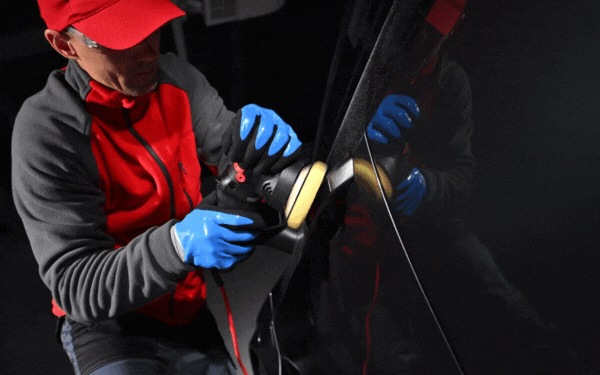
Use a dry cloth to wipe away car wax
Removing it from plastic doesn’t have to be difficult! Here are a few important steps to take when attempting to wipe away the wax from car plastics.
First, use a dry, soft cloth to gently clean the surface. While rubbing the area, use gentle pressure in even strokes until all of the wax has been removed. You should also avoid vigorous scrubbing and scratching as this can damage or discolor the plastic.
Pay attention to crevices and corners of the plastic where excess wax may be harder to remove. Don’t be afraid to use more abrasive methods in tougher areas, but take caution – using a tool that is too abrasive could scratch or damage your car’s plastic parts.
If all else fails, you can purchase a specialized automotive cleaner from your local auto parts store; however, these are usually stronger than necessary for typical home users and should only be considered as a last resort.
Use a damp cloth to remove any remaining residue
When the majority of wax has been removed, use a damp, soft cloth to gently rub the surface in circular motions. This will help remove any remaining wax residue that may have been left behind. Be sure not to press too hard on the plastic as this could cause scratching or indenting, marring its appearance. Additionally, make sure that no excess liquid and not too much friction are used on the plastic as these can both damage the material.
Once all of it has been removed, dry off any remaining moisture with a clean towel or rag to prevent water droplets from forming and leaving streaks or damage. You can also use a soft cloth to buff away any streaks from wiping leaving your plastic looking like new!
Post-Cleaning
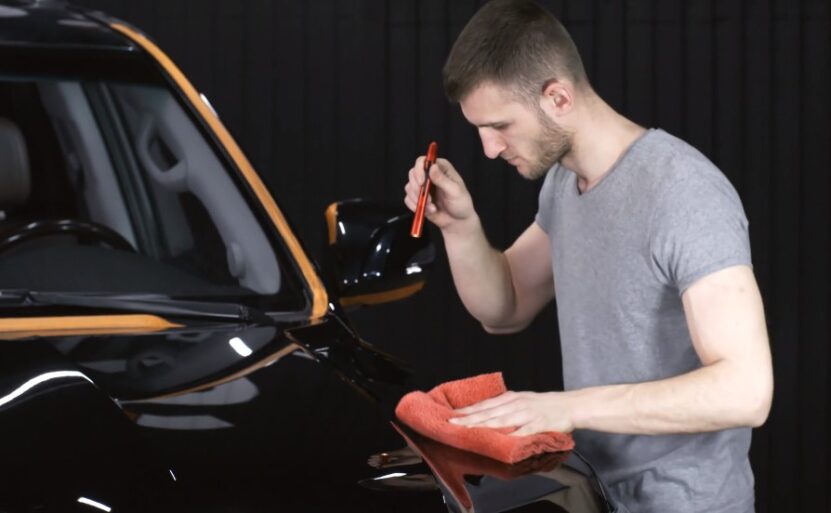
The next important step of car maintenance is post-cleaning. This involves detailed cleaning of the car surface to ensure that the waxed surface is in perfect condition.
One of the more difficult challenges of post-cleaning is removing wax residue from plastic surfaces. In this article, we’ll look at the best methods for removing car wax from plastic.
Dry the area with a clean cloth
Once you have removed the wax from the plastic surface with a sponge or cloth, it is important to dry the area thoroughly with a clean cloth. Too much water can cause streaking on painted surfaces and can promote the growth of mildew on unpainted surfaces.
If necessary, you can use a slightly damp rag to remove any remaining wax. Be sure to dab and not scrub so as not to create scratches in the paint or plastic.
When you are finished, be sure to inspect your car for any signs of residual wax before applying a new coat of car wax or polish.
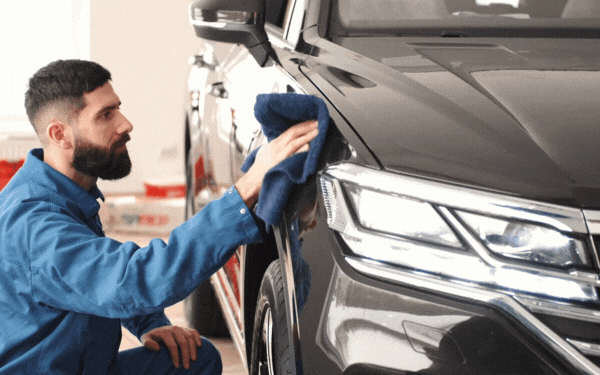
Apply a plastic protectant
Once you have removed the car wax from the plastic, it is important to condition and protect the plastic with a protective agent. There are a variety of spray-on protectants available at most automotive supply stores. Make sure to read through the label carefully before purchasing to ensure that it is specially formulated for plastic surfaces.
When applying a protectant, begin by spraying a light coat of product onto the surface of the plastic. Wipe off the product with a clean microfiber cloth and buff it on the surface until all excess product has been wiped away. Additional coats may be necessary if your car’s plastic is extremely faded or weathered. Make sure to allow each coat of product ample time to sink in before applying additional coats — most products require 24 hours between each application for optimal protection.
Buff the area with a clean cloth
Once all of the debris has been removed, it’s time to buff the area with a clean cloth. Depending on how much build-up you have and how delicate the plastic is (some plastics are more fragile than others), you may want to start with a dry cloth or one dampened with water.
Work in small sections, using gentle pressure and a circular motion to buff, then follow up with a dry part of your cloth. Repeat this process until all the wax is removed, but be sure not to use too much pressure or you may damage the plastic.
If needed, you can slightly dampen your cleaning cloth throughout this process, but be sure that it’s not too wet as excess moisture may also damage plastic surfaces.
FAQs
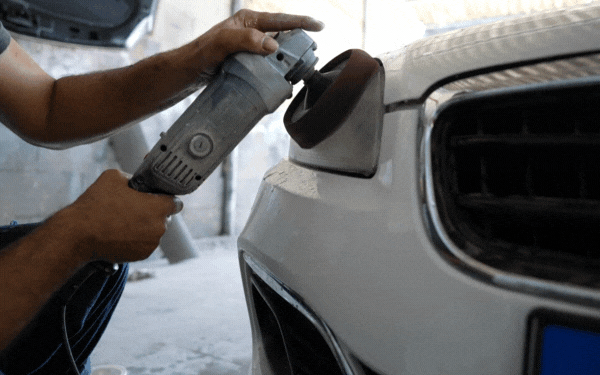
What should I do if the car wax has been on the plastic surface for a long time?
If the car wax has been on the plastic surface for a long time, it may be more difficult to remove, and a stronger cleaning solution or professional cleaning may be necessary.
Can I use a pressure washer to remove car wax from plastic?
Using a pressure washer can be effective for removing car wax from plastic, but it should be used carefully to avoid damaging the plastic surface.
How can I prevent car wax from getting on plastic surfaces in the first place?
To prevent it from getting on plastic surfaces, cover the plastic parts with tape or plastic wrap before waxing the car.
Will remove car wax from plastic damage the surface?
Removing it can damage the surface if abrasive tools or harsh chemicals are used. It is important to use gentle cleaning methods and test on a small, inconspicuous area first.
Can I use a magic eraser to remove car wax from plastic?
A magic eraser can be effective at removing car wax from plastic, but it should be used carefully to avoid scratching the plastic surface.
How often should I remove car wax from plastic surfaces?
You should remove car wax from plastic surfaces as needed, but it is generally recommended to do so once or twice a year to maintain the appearance of the car.
Can I use plastic polish to remove car wax from plastic?
Yes, a plastic polish can be effective at removing car wax from plastic and restoring the surface to its original shine.
Should I wear gloves when removing car wax from plastic?
It is not necessary to wear gloves, but it may be a good idea to protect your hands from any harsh chemicals that may be used.
What should I do if the plastic surface is still discolored or stained after removing the car wax?
If the plastic surface is still discolored or stained after removing the car wax, a specialized plastic cleaner or professional cleaning may be necessary to fully restore the surface.
Conclusion
Removing it may seem like a daunting task, but with the right tools and techniques, it can be done easily and effectively. From using household items to specialized cleaning products, there are several methods for removing car wax from plastic surfaces. By following the tips and steps outlined in this guide, you can safely and efficiently remove car wax from your car’s plastic parts without damaging the surface.
It is important to use gentle cleaning methods, test on a small area first, and take care not to scratch the plastic surface. Whether you are trying to clean up a wax spill or maintain the pristine appearance of your car, these methods will help you achieve the desired results. Remember to always take preventive measures, such as covering plastic parts before waxing, to avoid future wax spills. With a little effort and patience, you can restore your car’s plastic surfaces to their original shine, giving your car a fresh and polished look.

